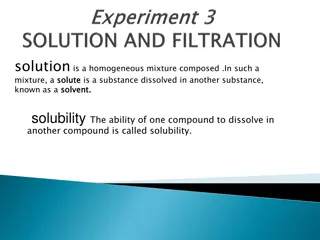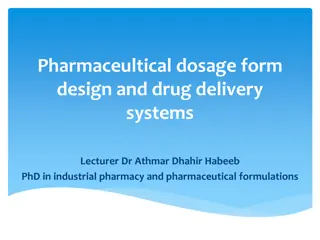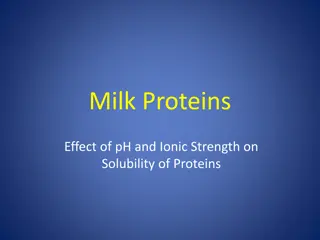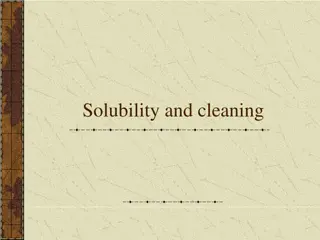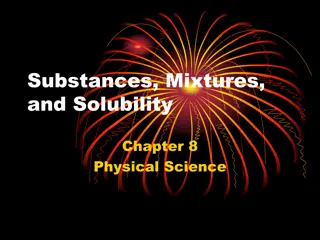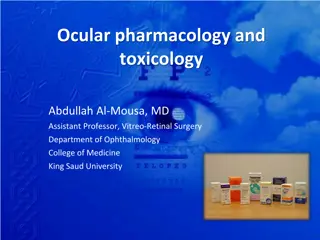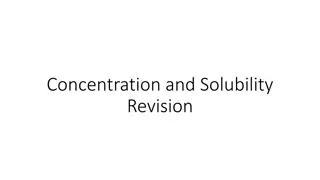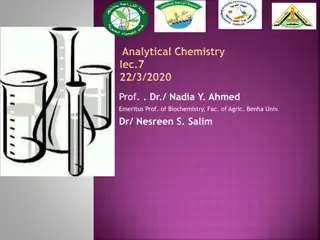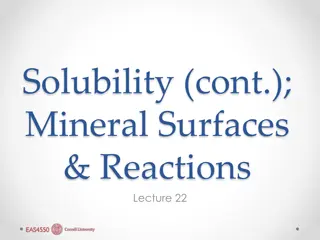Understanding Solutions and Solubility in Chemistry
Explore the concepts of solutions, solvents, solutes, and solubility in chemistry through investigations with various substances and solvents. Learn how to differentiate between dilute, concentrated, and saturated solutions, measure solubility, create solubility curves, and understand crystallization processes. Discover the factors influencing fair testing practices and gain insights into the formation of crystals and their industrial applications.
Download Presentation

Please find below an Image/Link to download the presentation.
The content on the website is provided AS IS for your information and personal use only. It may not be sold, licensed, or shared on other websites without obtaining consent from the author. Download presentation by click this link. If you encounter any issues during the download, it is possible that the publisher has removed the file from their server.
E N D
Presentation Transcript
At the end of this unit you should: 1. Be able to explain the terms solution, solvent and solute. 2. Know the differences between dilute, concentrated and saturated solutions. 3. Be able to measure the solubility of a substance by investigation, and draw and explain a solubility curve. 4. Know how crystallisation from a saturated solution happens. 5. Know examples of crystals, their uses and how crystals are created in industry.
concentrated solubility curve concentration soluble crystallisation solute dilute solution dissolve solvent insoluble suspension saturated universal solvent solubility
Investigation 06.02.01: How well do substances dissolve? Equipment: (Solvents) tap water, milk, vinegar, 50% alcohol-water mix, (Solutes) table salt, chalk dust (Calcium carbonate CaCO3), coffee granules, dry clay, custard powder, four 400 ml beakers, five boiling tubes (with corks), five weigh boats (or clock glass, circle of filter paper), spatula, top-pan balance, 25 ml graduated cylinder, test tube rack.
Instructions: 1. Fifteen ml of each solvent should be placed in a test tube. 2. Measure four 1 g amounts of each solute and add one sample to each test tube. 3. Shake each test tube equally vigorously and for the same length of time. 4. Each test tube should be allowed settle for thirty seconds before examining. 5. Decide whether a solution has formed in each test tube, and record your results. 6. Rinse each test tube and repeat the procedure with each of the other solvents.
1. Did each substance dissolve in the same way? Do your observations back this up? A variety of solubilities is shown across the test substances. The formation of layers proves that the solutes do not dissolve in the solvent. It also shows that substances are not automatically water soluble and that other substances are solvents also.
2. Can you show that you carried out a fair test? Justify your answer. Factors affecting a fair test: room temperature amount of solute used amount of solvent used the amount of shaking of each mixture time allowed for settling after testing qualitative descriptions cloudy, clear, etc. what decides whether a solute is dissolved?
3. List the substances in order of how well they dissolved. How did you decide this list? The solute that dissolved in the greatest number of solvents was the best solute.
Solution: A mixture in which a solute has been dissolved into a solvent. Solute: The substance that is dissolved into the solvent. Solvent: The liquid into which the solute is dissolved.
Concentration: The mass or volume of solute dissolved in a solvent. Dilute: A solution that has a small amount of solute and a large amount of solvent. Concentrated: A solution that has a large amount of solute dissolved into a small amount of solvent.
Fig. 06.02.02 A selection of concentrated cordial drinks (a) Fig. 06.02.02 shows a selection of cordial drinks. Each is in concentrated form. What does this mean? Concentrated form means the solutions contain a large amount of solute compared to the amount of solvent.
Fig. 06.02.02 A selection of concentrated cordial drinks (b) Can you drink cordial directly from the bottle? Why? It is possible but it means that you will be drinking a number of substances at a very high concentration, which could cause you to become ill.
(c) Table 06.02.01 gives a list of solutions. Copy and complete this table, writing into the boxes the substances you think are the solute and solvent in each solution. soap water coffee granules hot water milk ice-cream salt water chlorine/disinfectant water limestone/volcanic rock water chlorine/fluorine water blood cells/ wastes/ oxygen plasma (water in blood)
Solubility: The ability of a solute to dissolve in a solvent. Soluble: A solute that can dissolve in a solvent. Insoluble: A solute that cannot dissolve in a solvent.
Suspension: A mixture where insoluble solids will sink to the bottom of the solvent if left still. Saturated: A solution that has the maximum amount of solute dissolved into the solvent at a given temperature.
LIGHTBULB QUESTION The ideal temperature is 25 27 Celsius. Oxygen is passed through the water. Increased temperature causes the oxygen to escape from the water tank because it reduces its solubility in water. Keeping a steady temperature and bubbling air through the water tank means that the fish have a steady supply of oxygen.
Use the graph in Fig. 06.02.04 to answer the following questions: (a)Estimate the solubility of copper sulfate crystals at 700C. 47 g/100g of water (b) At what temperature was the solubility of the copper sulfate 30g/100g of water? 430C
LIGHTBULB QUESTION While you are carrying out Investigation 06.02.02, consider: how can we slow down the formation of crystals? Is the size of the crystal linked to how fast you evaporate the liquid in a mixture?
Investigation 06.02.02: Growing crystals of copper sulfate (or aluminium sulfate) Equipment: Hot plate, sufficient solute to make 500 ml of saturated solution, stirrer, spatula, six petri dishes (or clock glasses), kettle, small water trough, Styrofoam (insulated) box, iced water, top-pan balance, weigh boats, 1 000 cm3 beaker.
Instructions 1. Using a top-pan balance, measure out the required mass of solute to make 500 ml of solution (see Table 06.02.02). 2. At room temperature, add the solute to 1 000 cm3 of deionised/distilled water, with continuous stirring, until fully dissolved. 3. Place the beaker on a hot plate and heat to 500C. 4. Add solute until no more will dissolve (saturation). Stir thoroughly between additions to ensure dissolution of the solute. 5. Transfer half of the solution to a pre-heated small glass trough sitting in a basin of boiled water. The apparatus should be set aside and allowed to cool. 6. Transfer enough solution to each pre-heated petri dish to half fill it 7. The remainder should be placed into an ice-bath and allowed to cool. 8. The solution should be checked daily over a period of 3 5 days. After this, the size of the crystals produced by each method should be compared.
1. How will you know that the solution is concentrated? No more solute will dissolve into the solution at that temperature. 2. How can you cool the solution? Pick a method of cooling and give reasons why you picked that method. The solution can be cooled naturally by leaving it out on the bench, or it can be cooled by placing the container in a cool place/ice-water to force the temperature to fall quickly. By placing a container either in an insulated place or in a hot water bath, the cooling time can also be slowed.
3. Compare your cooling method to the cooling method used by another investigator. Which method is better? Why? If your aim is to make crystals quickly, or ones that can dissolve easily, then cooling small amounts of solution naturally or a large amount of solution quickly are better methods. But if your aim is to make large crystals then allowing them to cool slowly at room temperature is the best method. 4. Should you only ever use one method of cooling in order to make crystals? Why? If you want to make large amounts of crystals of a certain size, and to do it consistently, then the same method should be used each time.
COPYAND COMPLETE In this unit I learned that a solutioncan be made by dissolving a soluteinto a solvent. A strong solution can be called a concentratedsolution and a weak solution is called a dilutesolution. Saturatedsolutions have the maximum amount of solutethat is possible at a certaintemperature. The solubility of a solid increases as temperature increases. The solubility of a gas decreases with the increase of temperature. Crystals are formed when saturated solutions are cooled.
1. Can you list four substances that are insoluble in water? Chalk, plastic, coal dust, cooking oil.
2. Fig 06.02.03 shows three solutions of copper sulfate. Decide which diagram is the dilute solution. Also decide which diagram is the saturated solution. A is the dilute. C is saturated.
3. Starting with a dilute solution, explain how to make it more concentrated. There are two ways to make a dilute solution more concentrated: (i) evaporate some of the solvent (ii) add more solute.
4. What is the difference between a suspension and a saturated solution? In a saturated solution, the maximum amount of solute has been dissolved at a specific temperature, but in a suspension the solute does not dissolve after stirring/shaking but settles at the bottom of the container.
5. If you needed to create a powder from a saturated solution, how would you cool the solution? Powders are small solid particles. Cooling a saturated solution will create a lot of small crystals quickly. The remaining solvent would then need to be evaporated, and the crystals allowed to dry out fully.
6. List three examples of suspensions in everyday life. Antibiotics dissolved in water; yogurts drinks; powdered chalk in water.
7. A student investigated the effect of temperature on the solubility of the salt ammonium chloride in water. She determined the maximum mass, in grams, of the salt that would dissolve in 100 g of water at various temperatures. The data from this experiment is given in Table 06.02.02. Solubility (g/100g of water) 29 37 46 55 66 77 Temperature (0C) 0 20 40 60 80 100 (i) Present the information in this table as a solubility graph.
(ii) Use the graph to estimate the solubility of ammonium chloride at 70 C. 60 g/100 g water.
(iii) What conclusion about the solubility of ammonium chloride can be drawn from analysis of the graph? Solubility increases as temperature increases.
8.An investigation of the solubility of carbon dioxide in water gathered the following results. (i) Plot this data as a graph. Solubility of CO2 3.4 2.5 1.7 1.4 1.0 0.8 0.6 (g of CO2 per kg of water) Temperature (0C) 0 10 20 30 40 50 60
8.An investigation of the solubility of carbon dioxide in water gathered the following results. (i) Plot this data as a graph.
(ii) Usually the solubility of a solid increases with increasing temperature. The solubility of a gas decreases as the temperature increases. Suggest a reason why this decrease happens. As the temperature increases, this means that more heat energy is being added to the solution. This added energy is converted to kinetic energy by the gas particles, which causes the particles to move further apart and eventually escape the liquid. When the particles of a solid solute begin to separate, they mix better with the solvent, unless heated to the temperature at which they become a gas.
(iii) From the graph, estimate the temperature at which the solubility of CO2is 2 g per kg of water. 16.5 C.




